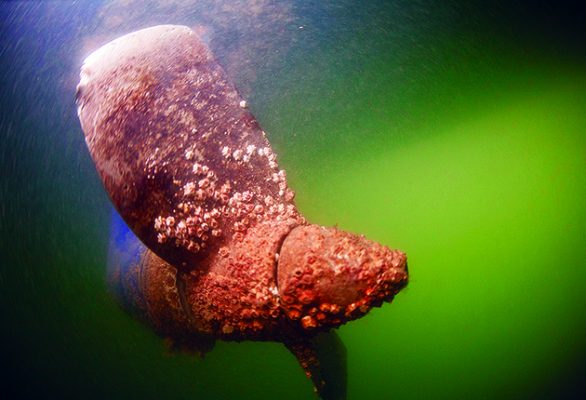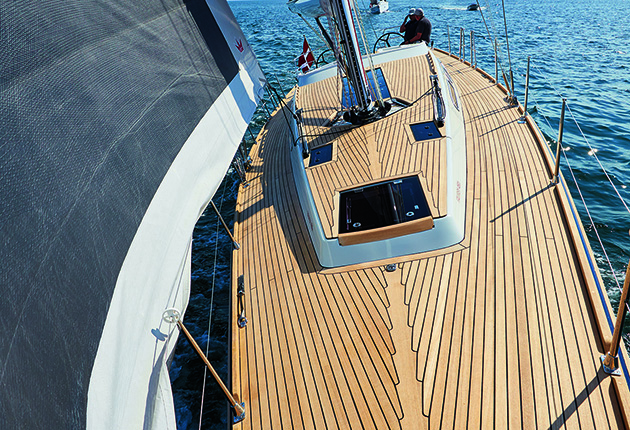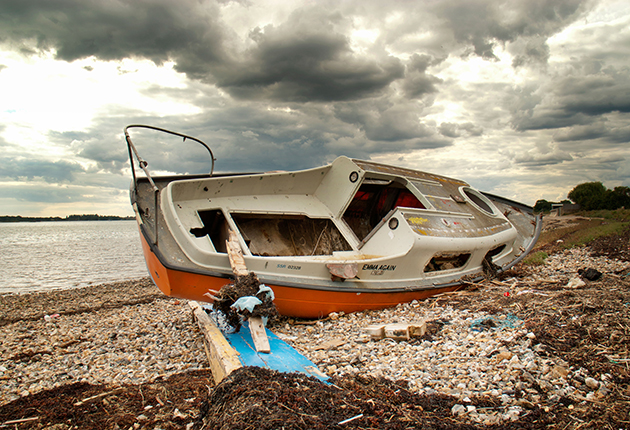While yachts are unlikely to introduce invasive species from abroad, they can help them spread around the coast. Sarah Brown explains
Invasive species are one of the leading threats to biodiversity across the globe, writes Sarah Brown.
Hundreds of marine species are marching across UK shores and seabeds, hitching lifts on our hulls and kit, and generally making a thorough nuisance of themselves.
Some of these invasive species pose a real threat to our enjoyment of sailing, the worst one (at the moment) seems to be Didemnum Vexillum.
A leathery carpet seasquirt which can grow rapidly, smothering everything it grows over, whether that is a mussel bed, an oyster bed, your prop, hull or water intake.

Cleaning your anchor and chain before leaving an anchorage can help prevent the spread of invasive species
The Marine Equipment Trade Show (METS) went online this year with a number of interesting sessions from experts in the sector from across the EU and beyond.
An active boater and marine biosecurity advisor, I was intrigued to attend the biofouling session with luminaries from world leaders such as Hempel, ICOMIA, World Sailing and the Glofouling project.
From the METS presentations we learned that it has been a difficult time for antifouling manufacturers with changes to regulations meaning a shifting baseline.
I have some sympathy for their difficulties, but as a sailor whose movements could be limited by biosecurity concerns, I am frustrated that it has taken this long to get it right.
It is indeed a contradiction: we want to protect the environment and limit the number and amount of harmful chemicals we put into the water, but then we also need to kill off these invasive species and stop recreational boats from being a vehicle to transport them from A to B.
In my biosecurity planning work I do get cross-examined by sailors.

Make sure you apply the proper thickness and number of coasts of antifoul. Credit: Graham Snook
The first question is usually something like, ‘Why should we bother when we didn’t introduce them in the first place?’
It is true, most marine invasive non-native species (INNS) probably didn’t arrive from the other side of the world on a 38ft cruiser.
Evidence suggests it is not recreational sailors who introduce these new species to the UK.
We do, however, spread them about the place and enable their transport into new and potentially vulnerable habitats. That much is for sure.
Continues below…
Eco friendly sailing: Best practice for green yachting
How easy is it to go eco friendly sailing? We look at the steps cruisers can take to minimise their…
How to antifoul your boat: a step by step guide
No one likes to antifoul their yacht, but keeping a boat free of the harmful growth is vital. Adam Fiander…
The dirty truth about teak
Teak is beloved by boat owners and shipyards for decking and yacht building, but any claims that it is sustainably…
What’s the future for derelict GRP boats?
With 9,000 GRP boats abandoned in Europe each year, finding disposal solutions isn't easy. Could new technologies be the answer?…
The next question is then, ‘Why should we bother when it is not us that is affected?’
To those people I say look no further than the west coast of America where the vast majority of boat owners are prevented, by law, from doing their own antifouling maintenance in order to limit environmental pollution and reduce the risk from non-native species.
The truth is that everyone thinks they are getting picked on, whether it is fishing, aquaculture or recreational boating, and it is my job to make sure that everyone understands that they are not being picked on, they are being included in decisions which will impact how they get to operate in the future.
There is to be no panacea; there is no such thing as a non-toxic antifouling paint, though new options are gaining traction in the market.
Ultrasound is one technology which seems to be coming of age for instance.

New technologies, such as ultrasonic antifoul, can help, but may require a certain amount of boat speed to work properly
However, more options equal more complexity.
Some solutions are good for some marina situations, others better for cooler waters.
The UK marine environment is highly complex and boaters should be prepared to do some homework before applying the same paint as before.
What does all this mean for you as a sailor?
The good news is that all the new regulations mean that the products are getting safer for both you, the user, and the environment.
The amount of biocides in the paint is lower overall and the delivery mechanisms have improved.
New resins and therefore the arrangement of the molecules within the paint means that a little goes a long way so we need less paint containing less nasties to keep the barnacles and weeds at bay.

Sarah Brown learned to sail with her father, Brian Black. She cruises a Nicholson 32 and is a marine engagement consultant
The not-so-good news is that we need to stay on top of this issue and follow closely the advice of organisations such as The Green Blue.
We need to antifoul properly, ‘check, clean, dry’ regularly, wash down our anchors before moving, and above all we need to make sure our antifouling is working properly by using our boats more.
Another excuse to get out on the water!
However you set about maintaining your hull it has never been more important to keep it clean and stop those hitchhikers from moving about the country.
As climate change is starting to bite, we are seeing warm-water species making home in what used to be cooler climes and with the natives come the non-natives with potentially disastrous results.
For details watch our video at: www.yachtingmonthly.com/nonnativespecies
The Key Biosecurity Actions
Anything that gets in contact with the water has the potential to spread invasive species, whether it is your boat or your kit.
Here are some top tips to stay safe and clean.
Antifouling Paint
Talk to suppliers and manufacturers and find out the best type of antifouling paint for your needs.
Pay attention to the instructions when applying and use your boat regularly to make it work properly.
Stay Clean
The aim is not to move any sediments or other material about, so ensure you clean your anchor when you leave an anchorage, wash your trailer when you leave the dinghy park and make sure your hull is clean before you set sail.
Be aware
Events and regattas are a potential biosecurity hazard.
Ask all attendees to check their hulls before they leave home, clean all kit and dry out what they can to minimise risk.
Top UK Marine Invasive Species
Didemnum vexillum

Credit: Harry Goudge/CCW
Also known as the carpet sea-squirt or ‘sea vomit’.
It smothers all other species and competes for food.
It’s a particular problem for shellfish aquaculture and is in competition with native species.
It can cover large areas of seabed.
Darwin’s barnacle

Credit: Paul Brazier/CCW
This invasive species is now a widespread hull- fouling organism.
Originally from Australasia, it reproduces and grows more quickly than native barnacles and so can displace them.
Most widespread in estuaries in southwest England.
The striped barnacle

Credit: Diane Macdonald/Alamy
A less widespread pest but it is causing problems in the south east in particular.
The most worrisome of the new species is the Titan acorn barnacle.
Although now in Europe, it has yet to be recorded in the UK.
Invasive crabs

Chinese Mitten Crab. Credit: Arterra Picture Library/Alamy
The banks of the Thames are being undermined by the burrows of the Chinese Mitten Crab.
Equally dangerous to our native shore crabs are the brush-clawed crab and the Asian shore crab, first seen in the UK in 2014.
Top US Marine Invasive Species
European green crab

Credit: Getty
Native to north-east Atlantic Ocean and Baltic Sea, the European green crab has now spread and can be found in waters off North and South America, Asia, and Australia.
It preys on bivalves and other crustaceans, such as soft-shell clams and scallops, and consequently has impacted the shellfish farming industry.
It has also contributed towards the decline in native crab species.
Veined rapa whelk

Credit: ImageBroker/Alamy
A large marine snail native to the northwest Pacific, this whelk has now spread to the Mediterranean Sea, Norway, Spain and the Rio de la Plata estuary in South America.
It was found in Chesapeake Bay in 1998, probably after being transported in ballast water.
The whelk is a predator on bivalve molluscs, such as mussels, clams and oysters, and threatens native species.
Zebra mussel

Credit: Getty
Native to the Caspian Sea and the Black Sea, this bivalve mollusc lives in fresh and brackish water.
It was discovered in the Great Lakes in 1998, and has since spread to rivers and lakes in eastern and central North America, including the St. Lawrence and Hudson Rivers, and the head of Chesapeake Bay.
It competes with native species and fouls anchor chains and blocks water intake pipes.








